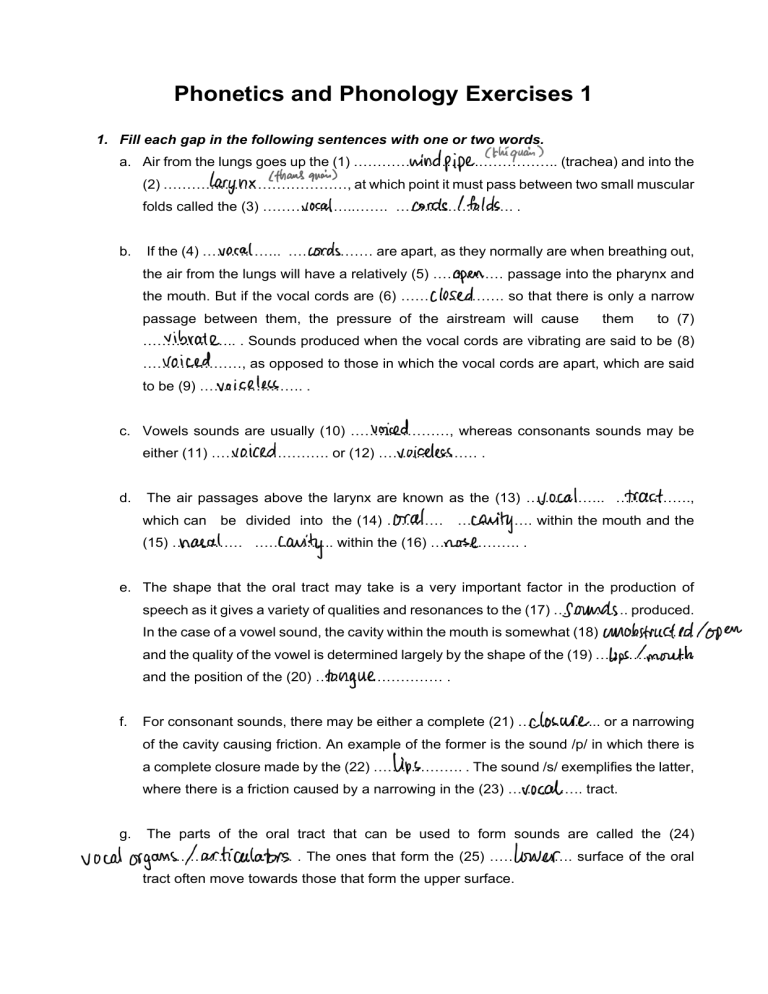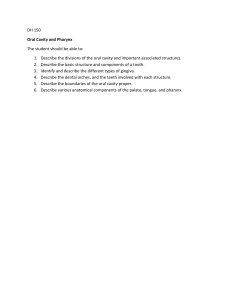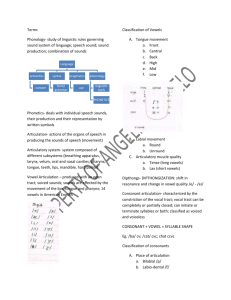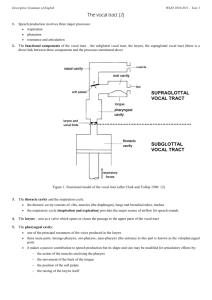
Phonetics and Phonology Exercises 1 1. Fill each gap in the following sentences with one or two words. a. Air from the lungs goes up the (1) ……………..……….…………….. (trachea) and into the (2) …………………………………, at which point it must pass between two small muscular folds called the (3) ………………..……. ……………………. . b. If the (4) …………….. ……………… are apart, as they normally are when breathing out, the air from the lungs will have a relatively (5) …………… passage into the pharynx and the mouth. But if the vocal cords are (6) …………………. so that there is only a narrow passage between them, the pressure of the airstream will cause them to (7) ……………….. . Sounds produced when the vocal cords are vibrating are said to be (8) …………………, as opposed to those in which the vocal cords are apart, which are said to be (9) …………………. . c. Vowels sounds are usually (10) …………………, whereas consonants sounds may be either (11) ……………………. or (12) ………………… . d. The air passages above the larynx are known as the (13) …………….. ……………., which can be divided into the (14) ………… ……………. within the mouth and the (15) …………… …………….. within the (16) ………………. . e. The shape that the oral tract may take is a very important factor in the production of speech as it gives a variety of qualities and resonances to the (17) ……………. produced. In the case of a vowel sound, the cavity within the mouth is somewhat (18) ……………….. and the quality of the vowel is determined largely by the shape of the (19) ………………… and the position of the (20) ……………………… . f. For consonant sounds, there may be either a complete (21) ……………... or a narrowing of the cavity causing friction. An example of the former is the sound /p/ in which there is a complete closure made by the (22) ………………. . The sound /s/ exemplifies the latter, where there is a friction caused by a narrowing in the (23) ……………. tract. g. The parts of the oral tract that can be used to form sounds are called the (24) ………………………….. . The ones that form the (25) ………..……. surface of the oral tract often move towards those that form the upper surface. h. The principal parts of the upper surface of the oral tract are: the upper lip, the upper (26) …………, the (27) ………………… ………………, the (28) …..…………palate, the soft palate or (29) ……………, the (30) ……………. and the pharynx. i. The soft palate is a muscular flap that can be (31) ………………to press against the back wall of the (32) …………………………….. and shut off the (33) ………….………… …………………, preventing air from going through the nose. In this case there is said to be a velic closure and an (34) ………………. sound is produced. j. When on the other hand, the soft palate is in its lower position, the air can escape both through the mouth and the nose. If, however, the mouth is blocked, the air, escapes only through the nose, and a (35) ……….……… sound is produced. k. The principal parts of the lower surface of the oral tract are the lower (36) ………., and the (37) ……………… . The (38) ……………. is usually divided into four parts: the (39) ……………, the (40) ……………., the (41) …………….. and the (42) ………………. . There is also the part lying opposite the walls of the pharynx, which is sometimes identified as the (43) …………….. . The (44) …………… and the (45) …………… are the most mobile parts of the tongue and they lie under the alveolar ridge when the tongue is at rest, whereas the (46) ………………… and the (47) ……………. lie opposite the hard and soft palate respectively. l. The lips are also important in the production of speech, taking up various different (48) ………………… . They can be held together, completely blocking the (49) ……………….. as when /p, b, m/ are pronounced. Conversely, they can be kept apart in a spread or neutral position or with different degrees of (50) ………………, such as the close-rounded or open-rounded positions. SPEECH ORGANS A) COMPLETE THE FOLLOWING DRAWING OF THE HUMAN VOCAL TRACT WITH THE CORRECT NAMES: 1. 2 3 4 14 5 13 7 6 8 12 9 10 11 LOWER TEETH - LARYNX - LIPS - HARD PALATE - EPIGLOTTIS ALVEOLAR RIDGE – NASAL CAVITY - TONGUE – GLOTTIS – PHARYNX – UVULA – VELUM - UPPER TEETH - ORAL CAVITY





